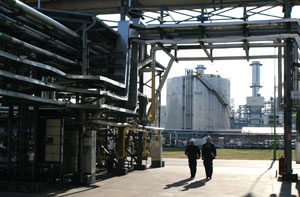
JANUARY 2007
Where the Rubber Meets the Roads (cover)
Poland Paces Field
Sofia's Choice of Many
Request Information

EASTERN EUROPE
Where the Rubber
Meets the Road
Meets the Road
 |
 James Howard, senior vice president of sales, marketing and carbon black technology for Columbian Chemicals Co., says the firm is expanding its carbon black plant in Tiszaujvaros, Hungary, in order to meet demand from the region's spate of new tire manufacturing plants. James Howard, senior vice president of sales, marketing and carbon black technology for Columbian Chemicals Co., says the firm is expanding its carbon black plant in Tiszaujvaros, Hungary, in order to meet demand from the region's spate of new tire manufacturing plants. |
| C |
ambridge Econometrics' recent report on the progress of the European Union's Lisbon Strategy for economic growth did not hold out great hope for Western Europe (EU15), but did for the east:
"On current estimates, output growth and productivity growth in the EU10 [accession states] are set to be between two and three times that of the EU15 over 2004-10," read the report. Strongest output growth sectors in the accession countries will be food and beverage, distribution/logistics, chemicals and professional services.
Separate FDI project data from Oxford Intelligence shows that the region's project leader from 1997 through 2005 was Hungary, followed by Poland and the Czech Republic. From there the project counts drop precipitously to the next batch of up-and comers: Romania, Slovakia and Bulgaria, in that order. The Czech Republic and Hungary also are out in front when it comes to public-private partnership deals on infrastructure, with both nations moving forward on large highway projects.
Hungary raised taxes in July 2006 in order to deal with a budget deficit projected to be close to 8 percent of GDP in 2006. But that hasn't slowed the pace of corporate projects. A September 2006 profile of Budapest from Jones Lang LaSalle reported an uptick in the city's industrial market, including the projected addition of 700,000 (65,000 sq. m.) of warehouse space by the end of 2006. That's in addition to the nearly 11.8 million sq. ft. (1.1 million sq. m.) already there, second only to Warsaw among major cities in central and eastern European countries.
Among the service-side newcomers to Budapest are a new call center for Unisys and the Global IT center for Citigroup, which opened in November 2006.
But it's still hardcore industry that resonates most in the region. Witness the October start-up of Pirelli's new tire plant in Slatina, Romania, as Hankook Tire and Bridgestone start up their own plants in Hungary and Michelin expands there too.
Those projects and more are why Atlanta-based Columbian Chemicals Co. is expanding its Columbian Tiszai Carbon, Ltd., carbon black plant in Tiszaujvaros, Hungary, says James Howard, the company's senior vice president of sales, marketing, and carbon black technology.
Columbian employs nearly 1,500 worldwide, and operates 11 carbon black plants in Ulysses, Kan.; Proctor, W.V.; Franklin, La.; Hamilton, Ontario; Cubatao, Brazil; Hannover, Germany; Santander, Spain; Bristol, England; San Martino di Trecate, Italy; and Cheonnam, Korea. The company also operates technical centers in its headquarters community of Marietta, Ga., a well as at its Brazil, U.K. and Korea locations.
In addition to tires, petroleum-derived carbon black also increases strength and durability of products ranging from inks and paints to plastics, coatings and nanomaterials. But Howard tells Site Selection that tires are where it's at for this Columbian project. In addition to the projects above, the expansion will also serve a Bridgestone joint venture called Brisa in Turkey.
"The facility supplies rubber carbon blacks, and by far the majority, from 65 to 70 percent, go into a tire of some sort," he says. "The balance is typically used in black non-tire rubber parts –belts, hoses, gaskets, that spongy black along the door frame of your car. Any time they're going to expand automotive production, it has a significant impact on demand for rubber goods, not just new cars, but in fact replacement tires are a bigger segment of the market than OEM cars."
Howard says the Hungarian plant is the company's newest in Europe, and as such is its showcase facility. But mundane details factor in too.
"Because of the nature of carbon black, the shorter transportation the better, so you try to locate close to your customers," Howard says. Freight cost is one factor, but so too is the behavior of the powder product during loading and unloading.
"It settles out in transport, so you have to spend more time mixing it back together," Howard explains. As a result, "we see a lot moving around in a region, but we don't see a lot of it moving across oceans to different market segments."
What determines a region's size?
"We have a map of Europe in my office," Howard says. "We like to draw a circle with a 500-mile [805-km.] radius. Beyond those limits, the economics and the cost of freight start to make it uneconomical." Also helping the location is a new highway very close to the plant.
Howard says the company had expansion in mind when it built the original plant in the early 1990s. And with so much customer concentration in central Europe, the choice of Hungary was an obvious one. Even so, he says, there are reasons besides customer proximity to look at Hungary.
"You're always looking for the highest skilled labor you can find, and Hungary has it," he says. "The work force is extremely well educated, and language skills are very good." That includes both German and English. But perhaps the best resource is the world-scale petrochemical site belonging to TVK on which Columbian's plant sits.
"We get a lot of our feedstock from that facility, we sell it some of our byproduct and the cogeneration capability in this expansion will be able to be sold to the grid or to TVK," says Howard. Asked how feedstock supply factors into site selection these days, he says, "Feedstock is a relatively large portion of our cost. Certainly the supply of good quality feedstock is a critical element. You want it to be as close as possible to the consumer – like our customers, we build in close to the source of feedstock. We're very fortunate with the proximity of that TVK facility. The balance is going to be sourced from other suppliers in the Central and Eastern European region. We have three suppliers lined up, but we don't have contracts finalized at this point."